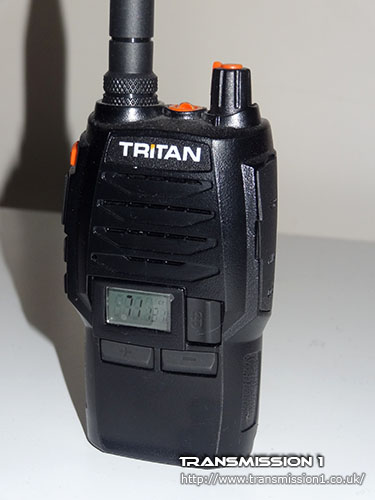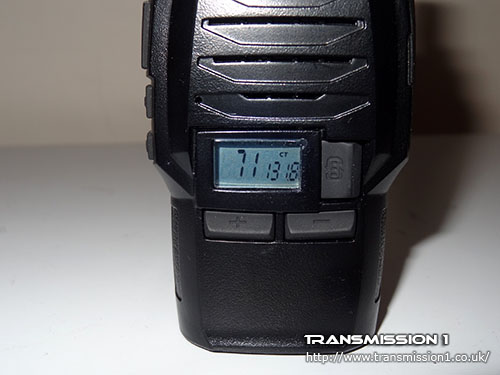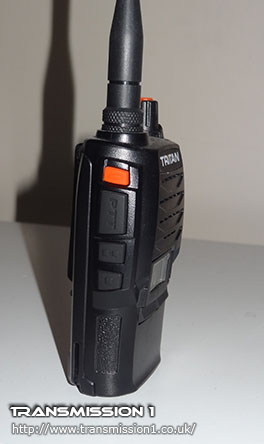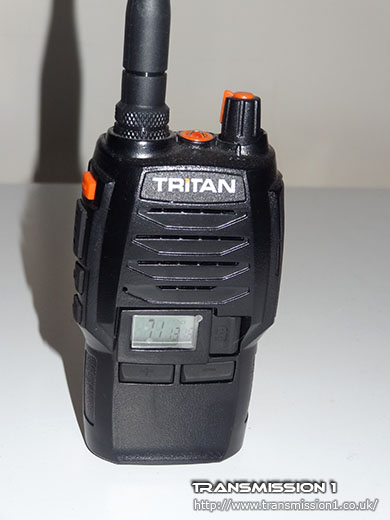

It doesn’t really seem like that long ago that I first reviewed a PMR-446 on the site, one of the earliest sets I looked at was the Cobra Microtalk 200 but it’s actually some 10 years ago now and the licence free band has been available across some European countries since 1998! Fast forward 14 years and just take a look at the range of radios available now. An almost bewildering choice – some aimed at leisure and home users and some aimed at business use. There is no denying that PMR-446 is great for certain tasks and applications but the bands can be very crowded in some parts of the country and in the towns and cities with so many shops using them too. This often causes interference to neighbouring users and reduces the range.
Many business users wanted something a little bit more powerful with a better range and not shared with the general public, thus the “UK Business Radio Light” bands were introduced by Ofcom. This is not in itself new but has recently had a name change. Business Light was formally known as “UK General” band but Ofcom wanted to take the opportunity to differentiate between fully licensed “professional two-way radio” and the half way house of occasional business without too many restrictions therefore allowing the radios to be used at any location within the UK without prior notice.
The UK Business Light licence costs £75 for five years usage and allows the use of up to 15 different frequencies spread out across 4 different VHF and UHF bands. Equipment currently on sale tends to have just one band built in but the licence covers you for operation of any number of handhelds across your business and at any given location within the UK. It is important to note that this is a UK only arrangement set in place by Ofcom and UK Business Light radio cannot be used elsewhere in Europe (unlike PMR-446). So why use UK Business Lite compared to PMR-446? There are several differences, firstly the power levels. Many of the UK Business Light radios transmit at up to 5w of output power compared to PMR-446 at just 0.5w so the range can be much better and secondly (and most importantly ) all the UK Business Light kit has removable antennas and provides the ability to connect external antennas such as a magnetic mount on a vehicle, therefore increasing the range much furter than a normal handheld with rubber antenna. The only restriction here is that the total ERP (effective radiated power) from the antenna system must not exceed 5W otherwise you will be breaking the terms and conditions of the licencing set out by ofcom. The full details of available frequencies are shown in this example licensing form provided by Ofcom: http://ofcom.org.uk/static/businessradio/BusinessRadioSimpleUK.pdf

That all aside, let’s now start to take a look at the Tritan City Traveller Package kindly loaned to me by Chris at Radioswap Communications. The variant of the radios loaned to me for this review is the UHF version operating up on the 449 MHz channels. This isn’t too far away from the PMR-446 frequencies so performance wise we already know what to expect from a handheld radio. The Tritan package is certainly comprehensive. The large glossy box contains just about everything you need to get started with this band and you won’t need to think about any accessories for a while because the list is extensive. 1 x Two Radio, 2 (yes two) x Li-Ion battery packs, 1 x desktop charger, 1 x car charger, belt clip, 1 x standard antenna, 1 x stubby antenna, 1 x micro magnetic mount vehicle antenna plus a user guide and most importantly an Ofcom Business Radio Light application form so you can stay legal! That really is quite a superb package for anyone getting started, the only thing missing from the deal in my opinion would be a nice leather case to keep the radio protected from knocks and scratches but you can’t have everything I guess! Hats of to Tritan in Rotherham for such a comprehensive package for business users.

The radio itself is a solid little performer, it feels well made but not too heavy in the hand at only 185g with the battery pack and the supplied belt clip is made of metal which is always a good thing as the plastic ones tend to be very flimsy and snap after heavy use, particularly on business radios that will get a lot of use over their working life. The radio is no bigger than the average PMR-446 set but has some suprising extras up its sleeve including a little but very bright LED torch squeezed in between the antenna and volume control and the radio even has an FM radio hidden away for those times when you might want a little music or listen to the news.

The packaging on the Tritan proudly announces that the radio has 128 channels but this not quite true as there are only 3 channels in the UHF band available but every valid CTCSS/DCS combination is pre-programmed into the 128 memory channels in the radio thus making “extra channels” available. It seems to be a bit of a marketing plot with manufacturers to boast about how many channels a product has. I guess you could say there are 128 combinations programmed into the radio making it compatible with most other UK Business Light radios available. Indeed the packaging states that the radio channel configuration is compatible with the popular Mitex range sold by a well known electronic chain store across the UK.
Dropping the Tritan into the supplied desktop charger with a fresh battery pack took almost 4 hours to recharge. The supplied Li-On batteries are 1200 mAH so should last a decent length of time. It is great to see that two batteries are supplied with every radio so you should never be too short of power. It is possible to charge the batteries directly in the desktop charger without the radio being present so you can always keep a plentiful supply of power going here. The charger has the standard red/green LED arrangements to indicate charging status and it’s impossible to overcharge a battery as the charger turns off when complete.

The Tritan is a very compact radio, the buttons are very rubberized but still easy to press. This keeps the radio waterproof against the odd rain shower when used outdoors or in a wet environment. The PTT (push to talk) button is compact but still easy to use in the hand and underneath the PTT there are two pre-programmed function keys that allow the squelch to be released so you can monitor activity on a channel (eg, when checking for other users in your local area or if a signal is breaking up so you can hear the transmission better without the squelch cutting in and out) and the ohter button toggles the radio between high and low power. High power being 5 watts and low power being 1 watt. If you are only using the radios in a small building you might want to experiment with this setting as 1w can travel suprisingly far and will definately save your battery power. There is absolutely no point in blasting out 5watts all day long if you are only a few hundred meters apart – it won’t do anything other than flatten your battery quicker and could interfere with other more distant users of the bands as the Business Light band is a shared resource in the same way that PMR-446 is run.
The LCD display on the radio is a (very) small window on the front of the set. This is a no-nonsense radio and doens’t have lots of indicators all over the place but this keeps it compact and robust. The display is backlit upon a key being pressed and illuminates with the help of a white LED. This is sufficient for night time use for the quite status update. The LCD display can show the current channel number, the CTCSS/DCS tone frequency in use, high and low power settings plus a very tiny little three segment battery indicator.
One surpise for me on this radio is the included car charger, this is really a bonus if you are away from home and need to give the radio a boost charge, maybe if you are camping for example and don’t have access to mains electricity. The charger connects directly to a port on the radio under the speaker mic flap located on the right hand side of the transceiver. According to the user guide you can charge the radio directly with this port but it cannot be used while the radio is switched on and takes up to 12 hours to charge the unit so this is a trickle with the built in circuit designed for overnight use more than anything but may just help if you are without mains for a long period of time.

The Tritan has been designed to keep things simple of business radio users, that means a lot of settings are pre-defined and very little adjustment is required in the menu of this radio and indeed, the options presented are limited compared to some generic Chinese import radios and amateur radio sets etc. This is done for two reasons, one to stop the user messing up the settings and two, to keep the user within the terms of the licencing conditions. With that in mind we now look at the menu on the radio. The menu key is located to the right hand side of the LCD display. A simple press will allow adjustment of the channel number between 1 and 128 and also change the CTCSS/DCS code automatically to one of the preset combinations. Other selectable options include turning the keypad beep on or off (recommended!) and setting the squelch levels in case of interference. Another option toggles the FM radio function on or off too. Most puzzlingly there are a couple of other options on the menu that appear to be unsettable, these include a VFO mode (free channel tuning) and a step size mode. I believe these apply to an “unlocked” version of the radio that can transmit on other frequencies than the Business Light band, possibly available outside of the UK in an export mode configuration. The actual product documentation states that the set can transmit between 400-470 MHz so I would imagine the Tritan is locked down to keep it legal and within the specification for the parameters set by Ofcom.
The antennas supplied in the box with the radio make for interesting possibilities. During my testing I used the standard rubber antenna but a short stubby antenna was also supplied. This is great for those situations where the range doesn’t need to be fantastic on the radio and makes the set much more “pocketable”. The best thing to do in all cases is experiment with the range of the antennas to see which one suits your needs best. If the short and stubby does the trick and you get the desired range then the radio will look much better all round and make it easier to carry, however if you want real range and you need to use the radios between vehicles in true convoy style then the mini-magnetic mount is the one you will need. Anyone who has ever used a handheld radio inbetween vehicles will know that the range isn’t fantastic because the antenna is surrounded by metalwork and the signals soon get atenuated as vehicles move apart. However with the mag mount and the 3 meter cable provided this makes for a very discrete solution with real power. The antenna is about 10 cm long so doesn’t really show up on the vehicle roof at all, it’s like a small black cellular phone type antenna so won’t look out of place at all and can be removed when not in use. With the 5 watt output power between two vehicles you could expect a very good range on the UHF band of at least several miles. The box packaging quotes up to 25 Km which could be true if you were travelling out in the open, across water or on a hill top but in reality you might get a 2-3 miles in a built up area with outdoor antennas. Again, experimentation and placement of antenna is the key to success here. During out tests we found that range varied tremendously depending on terrrain and how many other users in the area were transmitting on the Business Light bands. Seriously though, the mag antenna is a great addition to the package for travellers and makes the radio so much more usable where a standard PMR-446 radio would have given up after several hundred meters apart in vehciles and a built up area.

The sound quality of the unit was pretty good during testing, the built in speaker sounds tone rich and loud without distortion. This is always a good factor to measure a radio by since many business users could be using the radios in a noisy factory environment. A supplied earpiece also adds an additional dimension to the usabilty of the radio and simply connects to the accessory port under the flap on the right-hand side of the unit. We did notice that some kind of speech compression is used on this set, perhaps it’s actually an audio compander to make audio levels more consistent. This works great but if the signal level is low and the station you are listening to is breaking up it can have an effect of making the voice sound a little “fluffy” or scratchy. That said the overall audio quality from this radio was great and the range was better than expected for such a small handheld.
The range obtained from the standard rubber antenna was pretty much as expected, I managed about 2 miles in a built up area on high power without too much difficulty but out in the open we managed over 7 miles between units. The stubby antenna didn’t fare as well but for the size this was also expected, you can get around a mile out of this between units if you push things a little but it’s not been designed for distance work, it’s convenience more than anything else. One of the claims on the box is that these radios have 10 times more power than licence free radios but it’s important to remember that ten times more power doesn’t equal ten times more range in reality. Seriously, due to the laws of physics extra power will help but won’t make such as dramatic increase in range as you would be led to believe. The reasons behind this are complex but if you are interested in the why and how you’ll need to do some extra research on some good ham radio sites.

The LED torch is worthy of a quick mention too. Just simply press the orange rubber key just above the PTT bar and the single bright LED light will illuminate on the top of the radio. Whilst this sounds like a gimmick it actually does work quite well if you are operating in full darkness and saves carrying seperate torch if you just need to unlock a door and find the keyhole etc. It’s a nice extra feature. Likewise the FM radio is a bonus and it does work better than I imagined it would do. There are no memories to store your FM presets and the radio function just scans the entire FM band until it finds a signal. I tested this at work inside a highly sheilded office and I managed to pick up a couple of local FM stations with good clarity. Outdoors I was much more successful considering that the UHF antenna won’t really be cut for this range of frequencies.
When you consider the package you get with this radio and the accessories it seems like a good deal compared to some other big name brands. At the asking price of £99.95 from Radioswap Communications this represents good value for money when you consider what you would spend on accessories such as extra antennas, chargers, battery packs so for business users wanting to buy multiple radios this would be a good deal as the only extras you might want to purchase are cases. The performance of the radios on air exceeded my expectations and they are definately worth a look at if you need more power than PMR-446. The licence fee of £75 is reasonable for a five year period too.
Many thanks to Chris at Radioswap Communications for the loan of the two Tritan Travellers. I’ve enjoyed using testing them out around town and in the car.












Leave a Reply